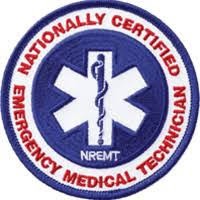
I have been very fortunate in my short life to be able to some things not everyone gets the opportunity to do. I have studied engineering, geology, and medicine. I earned my pilot’s license. I spent four of the best years of my life on a fire department. I worked as a personal trainer, framer, lifeguard, and at a shooting range. That said, hands down one of the most rewarding and influential things I have done was become an Advanced EMT. But does it make sense for a prepper to do the same?
by J. Bridger, contributing writer
Being an EMT taught me to deal with pressure, make difficult decisions, and showed me a side of humanity most people don’t get to see. It was humbling. It was hard. And it was worth it.
If you have the prepper mindset, I will offer to you that medical knowledge is one of the most important skills you can have. In my opinion, it’s not something you can really learn on your own. You need expert guidance and practice.
- Can you differentiate between a panic attack and a heart attack?
- Can you stop an arterial bleed?
- Can you recognize a diabetic emergency, a stroke, or know when to begin CPR?
- If a young child is wheezing, would you administer Narcan, Albuterol, or Epinephrine?
- Would that epi be 1:1000 or 1:10,000? What dose? What route?
- Do you know the side effects and contraindications for that?
If you were an EMT you could say yes to all these things.
If you are considering an EMT course, I urge you to do it. I am going to tell you about my experience in class, certifying, and what the work life is like. If you are on the fence, hopefully this will give you the information you need to make a more informed decision.
What an EMT is and What an EMT is Not
An EMT is not a paramedic. An EMT is not a coroner, nurse, doctor, or advanced practice provider.
An EMT, or Emergency Medical Technician, is an individual that is trained and certified to provide emergency medical care. The care they provide is lifesaving, but usually not definitive. What I mean by that is they are not going to diagnose your asthma and form a stepwise treatment plan for you. Their job is to treat life threats and get you to a higher echelon of care.
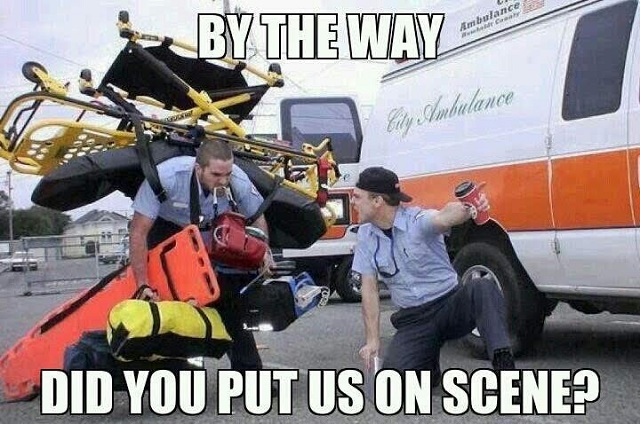
Depending on what state you live in, there are usually four types of emergency medical providers. Despite being a medical occupation, EMS (Emergency Medical Services) got its start under the National Highway Traffic Safety Administration in the 1960s. This is good and bad, as is everything when the government is involved. You will see what I mean.
EMR – Emergency Medical Responder
This may still be called “First Responder” in some areas, but it has recently changed. That was a poorly chosen name in the first place, as a first responder in my book could be the ambulance staff, cops, fire fighters, or bystanders. This level of training is below that of an EMT but is an attractive option for many reasons.
Cost of certification, length of program, and number of CE hours required to keep the certification are the lowest of the emergency medical techs. If you are seeking to supplement your skills as a LEO, volunteer firefighter, or for whatever reason, this certification deserves consideration. You will learn about common medical emergencies and how to assess and treat a patient.
EMT – Emergency Medical Technician
Formerly known as EMT-B or EMT-Basic in some areas. EMT is generally the entry level certification required to work on a fire department or on an ambulance. If you wish to be an AEMT or paramedic, you must start here. You cannot skip straight to a higher certification level (however, you may skip EMR). AEMT and Paramedic programs will certify you as an EMT initially. Program length will vary but is usually about a semester.
AEMT – Advanced EMT (EMT-I, EMT-D, or EMT-99)
This is an interesting level, as it gives you IV and IO skills that you didn’t have as an EMT. This allows you to give way more medications like lidocaine, epinephrine, morphine, fentanyl, normal saline, and more. It allows you to provide care at the Advanced Life Support level. This helps bring a higher level of care to areas where paramedics may be harder to come by (like rural areas). This is a great way to gain extra skills, training, and pay without committing to a two-year Paramedic program. Program length will vary but is usually another semester after you’ve obtained your EMT certification.
Paramedics – Mobile Intensive Care Technician or EMT-P
This is the highest level of certification, and their scope is impressive. IVs, drugs, advanced cardiac care, and some really bad ass skills are all performed by paramedics. Critical Care Paramedic and Flight Paramedic are additional certifications you can obtain. This is usually a two-year program but can be found as an accelerated 12-week program, or even two weeks (generally only for advanced practice providers, RNs, or physicians looking to obtain extra certification, see Creighton University).
What can I do as an EMT?
What is in an EMT’s scope? This will differ by state and local protocols. Maybe an EMT here can give this drug or do this skill, but in a different county, state, or hospital/ambulance service, they can’t. Confounding, I know. Don’t worry about it. It’s the name of the game. EMTs are trained to handle all kinds of things: taking vitals, obtaining histories, lifting and moving patients, securing the airway, physical exam, pharmacology, birth, bleeding, trauma, anaphylaxis, drug overdose, cardiac arrest, heart attacks, respiratory distress, stroke, heat and cold injuries, behavioral emergencies, fractures, head and spine injuries, and pediatrics just to name a few. It’s a blast, let me tell you.
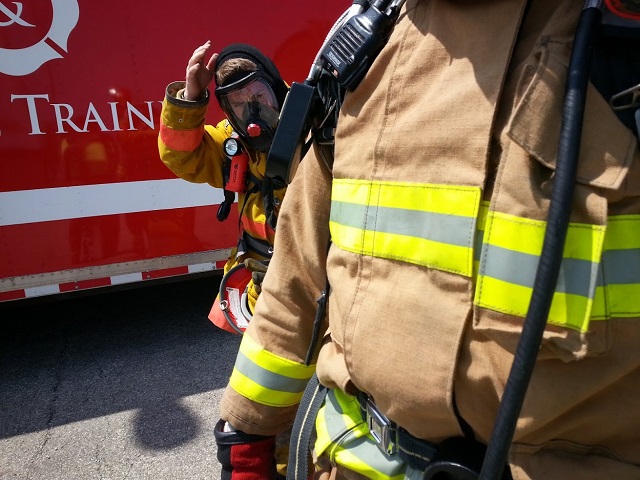
If you decide to become an EMT you will learn CPR, administer drugs within your scope according to your protocols (for example albuterol, oxygen, Narcan, activated charcoal, aspirin, nitroglycerin, oral glucose, and epi pens) and hand patients off to doctors and nurses. What are things you will not do?
Generally, EMTs do not start IVs, IOs, intubate, or manually defibrillate patients in cardiac arrest. You will use OPAs, NPAs, and supraglottic airways like king tubes or combitubes. If you work a cardiac arrest, you will use the monitor in AED mode instead of identifying and shocking the rhythm manually. You will not declare people dead, and you will not give pain meds like morphine and fentanyl. I have heard of states where EMTs start IVs and intubate, but I’m not sure if that’s legit or gossip. This is just from my experience.
What’s the cost to become an EMT?
If this is something you are looking into, I bet cost is on your mind. There is a lot of variation between programs. The best thing you can do is search out the information on your local college’s website. My EMT program was less than $3,000 in 2015. My AEMT program was less than that and was at a different school.
A paramedic program, usually part of an associate degree program, may cost you $10,000 or more. Don’t fret, because it is generally part of a degree program (eligible for student loans). Because I was not degree seeking, my EMT and AEMT classes were not eligible for loans. However, the fire department picked up the cost for me to certify. If being a firefighter is your end goal, you may be able to get a similar deal.
What is the EMT class schedule and time commitment?
You will hear me say this a lot, and that’s because its true: your mileage may vary. My EMT class was Monday and Wednesday nights from 6pm to 10pm, and this went from January to July. Some nights we got out early. Some nights we didn’t.
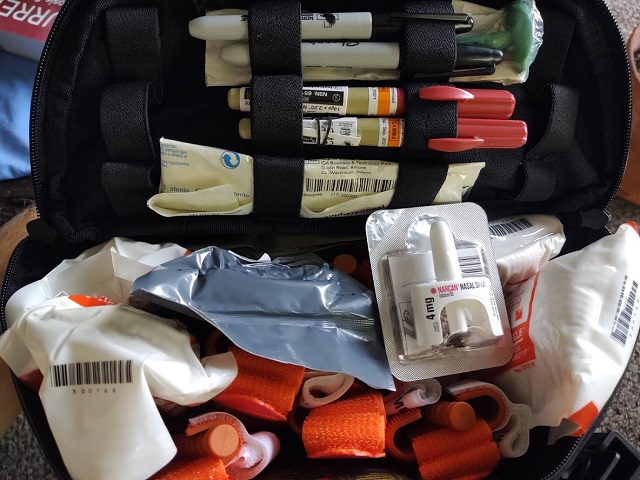
My advanced EMT class was Tuesday and Thursday nights from 6pm to 10pm, but this was only for a semester (16 weeks). There are hybrid programs that allow you to do the classroom work online but require you to physically attend to learn the skills. I have no experience with these.
I can’t tell you what paramedic school is like, but if it’s an associate’s program, there may be classes like anatomy, physiology, math, and English along with your medical classes. In my experience, EMT classes are offered with the assumption the student is working full time, so finding evening classes shouldn’t be an issue.
What are EMT classes like?
Class was pretty cool. We had to buy EMS boots, pants, and a student polo. We wore these to every class. You should buy the textbook. Its big, but it’s got a TON of great information in there. It is something like 40 chapters. The first few are pretty boring. Medicolegal and ethical issues, documentation, communication, lifting and moving patients, you get the idea. Remember when I said the government had its hand in the start of EMS? Now you see what I mean.
Never fear! If it was easy everyone would do it. Your persistence will be rewarded with knowledge in respiratory and cardiovascular emergencies, environmental emergencies, poisonings, shock, trauma, bleeding, securing the airway, and more. Don’t let it overwhelm you. Going from zero to hero may be challenging, but it is worth it.
We generally covered one chapter each class and had a quiz on it at the start of the hour. It was their way of making people read. (Jokes on them, I found all of it on Quizlet). We had an exam over 5 or 6 chapters at a time, and a final exam at the end. We had to pass the final exam to pass the class and be eligible to certify.
In addition to classroom work, we also worked on skills, which I will outline for you here. As an EMT, there are 10 skills you must be able to perform (EMRs have less, AEMTs and medics have more). Those are:
- Patient Assessment/Management – Trauma
- Patient Assessment/Management – Medical
- BVM Ventilation of an Apneic Adult Patient
- Oxygen Administration by Non-rebreather Mask
- Spinal Immobilization (Seated and Supine Patient)
- Bleeding Control and Shock Management
- Cardiac Arrest Management/AED
- Joint Immobilization
- Long Bone Immobilization
Don’t let this stress you out. I promise, if you’re reading this, dumber people than you have passed these skills! The skill sheets are on the National Registry of EMTs (NREMT) website, and you can download or print them at nremt.org. Just google it, and it will pop up. Your program WILL go over these skills with you, critique you, drill them into your head, and make sure you are good to go when it’s time to certify. If they don’t, find another program.
Lastly, there is “clinical” or ride along time. It is generally not much. For my EMT class, we needed 12 hours in the ER, and 36 on the ambulance, which equated to four 12-hour shifts. They set these up for us, and all we had to do was sacrifice two weekends to bust them out. It’s okay to be nervous, but don’t let it get to you. If you are polite and genuinely want to learn, chances are you will be well received by the crew you are working with. You may see ZERO patients in 12 hours on the ambulance, or you may run your ass off.
One of my twelve-hour shifts, we had no calls and I studied all day. Another student saw a cardiac arrest, necrotizing fasciitis in the perianal area, and an MCI (mass casualty incident) involving a horse and buggy. All in one day! Sadly, that student quit despite the fact that it was an honest to God anomaly. This is your chance to learn and see some cool stuff without any responsibility. If you’re lucky, they’ll even feed you.
What is EMT certification like?
Certification is a colossal pain in the ass, no two ways about it. You will need to do three things to certify:
- Pass an EMT course (Including CPR certification),
- Pass a written cognitive (knowledge) exam (this is done on the computer), and
- Pass a skills or “psychomotor” examination.
Let me say this now, because I hear it all the time:
- NO, because you were a medic in the military, they will not let you skip the EMT class.
- NO, just because you are a CNA, LPN, RN, or whatever, they will not let you skip the EMT class.
- NO, just because you “studied 2 years of premed” they will not let you skip the EMT class.
It doesn’t matter if you are an ER physician: You must have successfully passed a state approved EMT course within the last two years. If you’re looking for shortcuts, EMS is not for you.
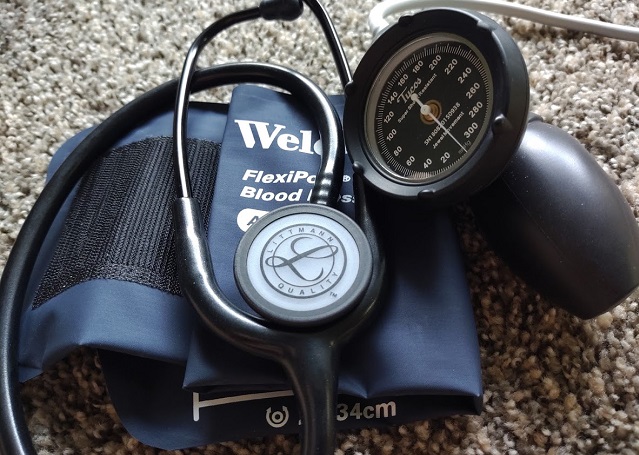
Now, the written test. The written test is adaptive. That means if you get a question correct, the next one is harder. If you get it wrong, the next one is easier. Once you get past a certain level of difficulty, or whenever it determines you’re a dumbass, it shuts off. No warning.
My exam was about 75 questions. Someone else’s may be 100. It just depends. This must be taken at a certified testing center, like a college or library. I think mine cost something like $75. My best advice for this is to take it immediately. Don’t wait. If you wait, you will lose information. Review the chapter summaries and questions in the book. Take it as soon as possible.
Once you have passed, your result is valid for one year. You should know you passed in a couple days. I remember seeing my results online somewhere. Once you have done that, all you must do is pass the skills examination. This will cost you $80 just to apply, and the exam site will charge you another fee. I think mine was $125. It sucks, but it takes a lot of people to put these exams on, and a lot of them volunteer their time.
My best advice is to study your ass off, and don’t freak out. The examiners see tons of kids come through. Most of them are awkward, suck at the skills, or are way too nervous. Just like in shooting – practice, practice, practice. They will be able to tell immediately if you know what you’re doing. Just memorize the check sheets and do your thing. No big deal.
Being calm will help you think. You will know the same day if you have passed the skills or not. If you fail a section, you may be able to retest the same day. I know these skills seem like a pain in the ass, but they will give you something to fall back on when the shit hits the fan and everyone is looking at you, expecting you to know what to do. Trust me, I’ve been there.
Now that you’ve crushed the course, written exam, and skills exam, you just wait for your shiny card, patch, and certificate to come from the NREMT. Now, you get to deal with an entire other huge pain in the ass: recertification.
What about EMT recertification?
Initially, you are required to certify with the NREMT. Why? Probably money. After that, you only need to recertify every two years with your state. They let you do this a few different ways. You can take the written and skills exams again, or complete continuing education credits in specific areas. You will need 40 hours in cardiovascular, medical, trauma, airway, and operations. You can get the CE’s by sitting in on an EMT course, going to conferences, taking refresher courses, or through your workplace. You will log these hours on their website. It’s kind of a pain but being a hero ain’t easy.
What is working as an EMT like?
Now that you have your EMT cert, the real education begins. I thought I was ready to kick ass when I was a new EMT, and I learned very quickly I was in over my head. Luckily, I worked with some very patient folks that took me under their wings. They let me struggle just enough and taught me a lot. You can work for an ambulance service, an interfacility transfer service, or a fire department. A lot of casinos hire EMTs as security. You could seek out a search and rescue team (usually volunteer). The more patient time you get, the better. Otherwise, your skills deteriorate.
Working as a full time EMT has its ups and downs. The first day, they told me 1 in 26 calls was a true emergency. I called BS, but they were absolutely right. In EMT class, they teach you everyone is dying. In real life, we ran 911 calls for spider bites, week old injuries, toe aches, an eyelash in the eye (I am NOT kidding), psych issues, and lots and lots and lots of lift assists. That’s okay.
If every call was a legit trauma or medical emergency, it would get old, fast. The pay is generally not great, and I met lots of EMTs with second jobs. You can pick up extra shifts and make decent money if you want to. The work is stressful, and erratic. You may run 10 calls a day, or zero. You may sleep all night through a 24-hour shift, or you may run all night. You may not get to eat. You may start to shower or put some chow in the oven and get a 911 call. You just never know.
A lot of people let their health go. It’s easy to do. Don’t be that person. Stay healthy. Exercise and eat well. Sleep when you can. Your heart and your back will thank you when you’re old.
Should preppers become EMTs?
The average career in EMS is only about 5 years long. In my opinion it’s because of pay and working conditions. For this reason, I advise you to start with the end in mind.
Do you want to be a firefighter? Do you want to be more prepared? Do you want to be a paramedic? Are you doing this to climb the ladder at your local volunteer fire department or SAR team? Is this for personal growth, or are you using this as a stepping stone for a professional school?
No matter your reasoning, the experience and education you gain will be priceless. If you have experience or responses – sound off in the comments section.

3 comments
It would be interesting to try to set up a curriculum more focused towards specific prepper needs. Any ideas for topics?
I’ve always toyed with the idea of becoming an EMT or even paramedic. This was truly inspiring and VERY helpful! My husband was an EMT for only 6 months. He worked for a couple ambulance companies and quickly got burned out from the bad hours and bad pay, but he really learned quite a lot of medical knowledge. I really fear learning all the medical knowledge. Thanks for the very detailed outline of what it means to be an EMT and gain that medical knowledge.
I worked with a lot of Prepper’s, and medical skills was one of the most common shortfalls in everyone’s preps. My dad had been an EMT, and I wanted the knowledge, so – even though I had no interest in working in the field – I took the class.
EMT (EMT-B) was advanced first aid with a little more ‘Why’ behind it. Not what I was after, but I enjoyed the class and loved the clinical experience I got.
I wanted more skills – IV’s and some more airway management – so I went to AEMT school. Again, class was good, clinicals were great. I enjoyed it, and people told me I was good at it. I was hooked.
Fast forward 5 years, and I’m now a Critical Care Paramedic, Field Training Officer, and an Instructor. It’s a career I love, and it started with wanting to improve my medical skills for preparedness reasons.
There’s some info in this article I don’t quite totally agree with, but the bottom line is correct – if you’re thinking about it, do it!!